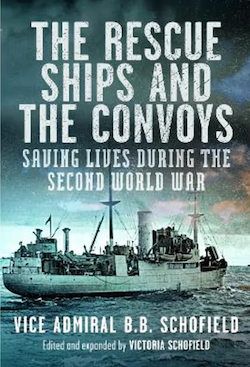
The Rescue Ships and The Convoys; Saving lives during the Second World War. By Vice Admiral B.B. Schofield. Pen & Sword, Barnsley, 2024.
Reviewed by Peter Jones
The Rescue Ships and The Convoys is an expanded new edition of Admiral Schofield’s definitive account of the British convoy rescue ships that was first published in 1968. Once again, the republishing of one of the Admiral’s books is the result of the endeavours of his daughter Victoria Schofield (see the recent book review of Operation Neptune).
In this case Victoria has applied her historian skills to delve into her father’s well-ordered papers to incorporate additional material into the new edition which her father received, mainly from veterans, following the publication of the first edition. The book is all the better for it.
Twenty-five small merchantmen were converted to be rescue ships and were fitted with additional accommodation, medical facilities, boats and other equipment to assist in recovering survivors from sunken merchantmen or their escorts. Later in the war five Castle class corvettes were also modified for the role. The concept was both innovative and extremely successful with over 4,000 mariners being rescued from the chilly waters of the Atlantic or the Norwegian Sea. Earlier convoys had shown that the established principle of the ships at the end of a convoy line automatically being designated the ‘rescue ship’ was deficient, in that these ships were ill suited to the required manoeuvring and recovery and had insufficient resources to succour the survivors.
It is commonly held that the resultant dedicated rescue ships were the brainchild of Admiral Sir Max Horton. According to Admiral Schofield, the first correspondence on the issue came from fellow submariner Admiral Sir Martin Dunbar-Smith, who in 1940 was Commander in Chief of the Western Approaches. Dunbar-Smith wrote to the Admiralty alerting them to the deficiency in extant arrangements and seeking a remedy. Staff discussions from members of the Admiralty Trade Division and officials at the Ministry of Shipping led to the concept of dedicated rescue ships and the creation of the Rescue Ship Service. Lieutenant Commander Louis Martyn was a driving force, and post-war his initial trove of documents given to Admiral Schofield was the genesis for the 1968 book.
Innovation is a recurring theme in this book. The early rescue ships honed techniques, devised better recovery equipment and wrote minutes on how to improve future ships. A reading of wartime British convoy reports also accord with this spirit of objective analysis and desire to improve effectiveness. The convoy enterprise was, in today’s parlance, a learning organisation.
A strength of The Rescue Ships is its account of the rescues of mariners in most difficult circumstances. This extended from able ship-handling by the rescue ships’ Masters, the bravery of deck hands and the skills of the naval sick-bay teams. The book offers useful behavioural observations of survivors and how best to deal with them onboard the rescuing ships.
While we may not see the like of convoy rescue ships again, the experiences of their crews, the close relationship between naval and merchant mariners and the spirit of innovation have lessons for today’s mariners.


